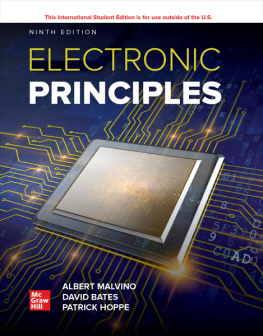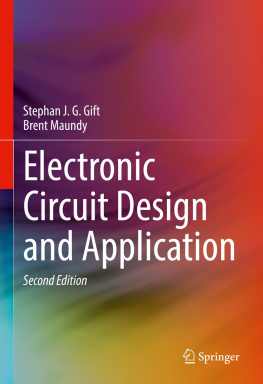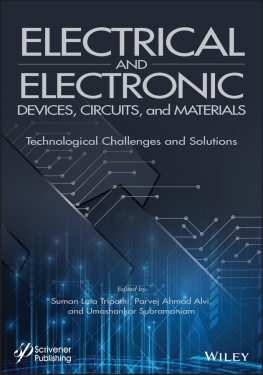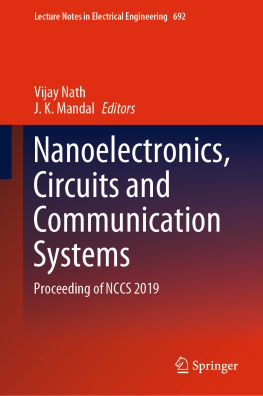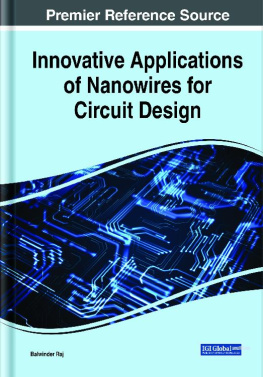
Electronic
Principles
Ninth Edition
Albert Malvino
David J. Bates
Patrick E. Hoppe

Page ii

ELECTRONIC PRINCIPLES
Published by McGraw-Hill Education, 2 Penn Plaza, New York, NY 10121. Copyright 2021 by McGraw-Hill Education. All rights reserved. Printed in the United States of America. No part of this publication may be reproduced or distributed in any form or by any means, or stored in a database or retrieval system, without the prior written consent of McGraw-Hill Education, including, but not limited to, in any network or other electronic storage or transmission, or broadcast for distance learning.
Some ancillaries, including electronic and print components, may not be available to customers outside the United States.
This book is printed on acid-free paper.
1 2 3 4 5 6 7 8 9 LWI 21 20 19 18
ISBN 978-1-260-57056-4
MHID 1-260-57056-8
Cover Image: Charles Smith/Corbis/VCG/Getty Images
All credits appearing on page or at the end of the book are considered to be an extension of the copyright page.
The Internet addresses listed in the text were accurate at the time of publication. The inclusion of a website does not indicate an endorsement by the authors or McGraw-Hill Education, and McGraw-Hill Education does not guarantee the accuracy of the information presented at these sites.
mheducation.com/highered
Page iii
Dedication
Electronic Principles, 9th ed. is dedicated to all students who are striving to learn the fundamentals and principles of electronics.
Albert P. Malvino was an electronics technician while serving in the U.S. Navy from 1950 to 1954. He graduated from the University of Santa Clara Summa Cum Laude in 1959 with a B.S. degree in Electrical Engineering. For the next five years, he worked as an electronics engineer at Microwave Laboratories and at Hewlett-Packard while earning his MSEE from San Jose State University in 1964. He taught at Foothill College for the next four years and was awarded a National Science Foundation Fellowship in 1968. After receiving a Ph.D. in Electrical Engineering from Stanford University in 1970, Dr. Malvino embarked on a full-time writing career. He has written 10 textbooks that have been translated into 20 foreign languages with over 108 editions. Dr. Malvino was a consultant and designed control circuits for SPD-Smart windows. In addition, he wrote educational software for electronics technicians and engineers. He also served on the Board of Directors at Research Frontiers Incorporated. His website address is www.malvino.com
David J. Bates was an instructor in the Electronic Technologies Department of Western Wisconsin Technical College located in La Crosse, Wisconsin. Along with working as an electronic servicing technician and as an electrical engineering technician, he has over 30 years of teaching experience.
Credentials include an A.S. degree in Industrial Electronics Technology, a B.S. degree in Industrial Education, and an M.S. degree in Vocational/Technical Education. Certifications include an A + certification as a computer hardware technician, and Journeyman Level certifications as a Certified Electronics Technician (CET) by the Electronics Technicians Association International (ETA-I) and by the International Society of Certified Electronics Technicians (ISCET). David J. Bates is presently a certification administrator (CA) for ETA-I and serves as an Education and Technology Program Coordinator for SpaceTEC Partners, Inc., located in Titusville, Florida.
David J. Bates is also a co-author of Basic Electricity a text-lab manual by Zbar, Rockmaker, and Bates.
Patrick E. Hoppe is a full-time Electrical Engineering Technology instructor and the Chair of Engineering at Gateway Technical College, located in Kenosha, Wisconsin. Since joining Gateway, he revised their Electronics program and developed their Electrical Engineering Technology program. Pat has earned local, state, and national teaching awards, including the NISOD Teaching Excellence award.
Pats educational preparation began at Milwaukee Area Technical College where he earned an A.A.S. degree in Biomedical Electronics in 1985. After graduation, he started his electronics career working on medical instrumentation. Pat continued his educational journey at the Milwaukee School of Engineering while he worked full time. Pat graduated with a B.S. degree in Biomedical Engineering and an M.S. degree in Perfusion. Pat continued working in healthcare until he accepted a teaching position at Gateway Technical College in 1999.
Patrick E. Hoppe is also a co-author of the experiments manual for this textbook.
Page ix
Preface
The ninth edition of Electronic Principles continues its tradition as a clearly explained, in-depth introduction to electronic semiconductor devices, circuits, and their use in system applications. This textbook is intended for students who are taking their first course in linear electronics but due to the comprehensive topical coverage, can be used in second- and third-semester solid-state electronics courses as well. The prerequisites are a fundamental knowledge of dc/ac circuits, algebra, and some trigonometry. Electronic Principles , ninth edition, can serve as an excellent follow-on textbook for Grobs Basic Electronics by Mitchel Schultz.
Electronic Principles provides essential understanding of semiconductor characteristics, testing, and the practical circuits in which they are found. The text provides clearly explained conceptswritten in an easy-to-read conversational styleestablishing the foundation needed to understand the operation and troubleshooting of electronic systems. Practical circuit examples, applications, and troubleshooting exercises are found throughout the chapters. Multisim circuit simulation files are used in the textbook to bring the circuits to life and help develop troubleshooting skills. These simulation files can be found and downloaded from the associated Online Learning Center (OLC) at http://mhhe.com/malvino9e. Extensive work was done to match the content in this textbook to its companion experiments manual, Experiments Manual to Accompany Electronic Principles .
Chapter 1, Introduction, sets the framework for the rest of the textbook. While some of the topics will be a review, this chapter is used to ensure all students understand the fundamentals of voltage sources, current sources, Thevenins theorem, and Nortons theorem and introduces the use of approximations as applied to electronics. Troubleshooting concepts are reviewed and expanded on with dc and ac troubleshooting techniques examined.
Chapters 2 through 10 cover the basics of semiconductor structure, diode theory, diode circuits with power supply applications, special-purpose diodes including the zener diode, optoelectronic devices, the bipolar junction transistor (BJT) introduction, BJT biasing, and BJT amplifiers, along with multistage and BJT power amplifiers.
Chapters 11 through 13 investigate field effect transistors (FETs) and thyristors. This includes device characteristics, circuits, and applications of junction field effect transistors (JFETs) and MOSFETs, along with an introduction to wide bandgap (WBG) power transistors using gallium nitride (GaN) and silicon carbide (SiC). The concepts of power half-bridge and H-bridge circuits are also explained. Included in the thyristors topics are SCRs, diacs, triacs, UJTs, and IGBTs.
Next page
